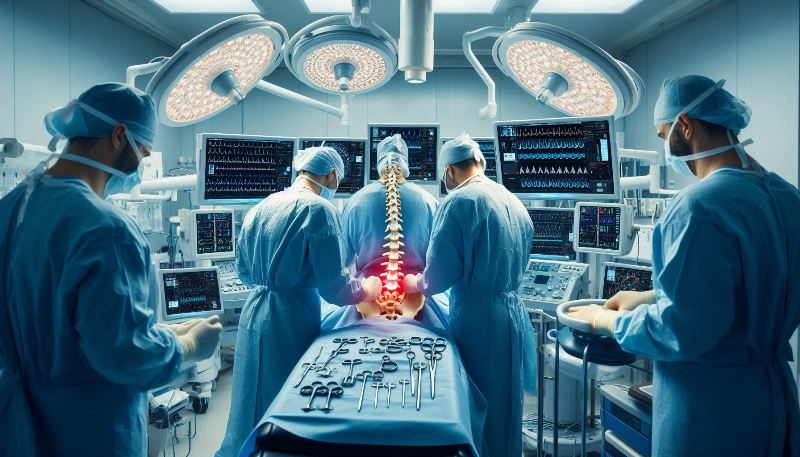Everything You Should Know About Disc Replacement Surgery

Disc replacement surgery is a type of spinal surgery that involves removing a damaged disc and replacing it with an artificial disc. This surgery is typically performed to relieve pain caused by a herniated disc or degenerative disc disease.
There are several different types of disc replacement surgery, and the best type for you will depend on your individual situation. The most common type of disc replacement surgery is anterior cervical disc replacement (ACDR). This type of surgery is performed through a small incision in the front of the neck.
ACDR is considered to be the gold standard for treating herniated discs and degenerative disc disease. It is associated with fewer complications and a quicker recovery than other types of disc replacement surgery.
If you are considering disc replacement surgery, it is important to consult with a spine specialist to discuss all of your options. Disc replacement surgery is major surgery, and it is not right for everyone. Your spine specialist will be able to help you determine if disc replacement surgery is the best option for you.
What Are the Different Types of Disc Replacement Surgery?
As we mentioned, there are several different types of disc replacement surgery, and the best type for you will depend on your individual situation. The most common type of disc replacement surgery is anterior cervical disc replacement (ACDR). Other types of disc replacement surgery include:
Posterior Cervical Disc Replacement:
Posterior cervical disc replacement surgery is a type of spinal surgery that is used to treat neck pain. The goal of the surgery is to relieve pain by removing the damaged disc and replacing it with a new one.
This type of surgery is typically performed on an outpatient basis, which means that the patient can go home the same day. The surgery itself takes about 1-2 hours to complete. The most common reason for people to opt for this type of surgery is to relieve pain that is caused by a herniated disc.
A herniated disc occurs when the inner portion of the disc leaks out and puts pressure on the nearby nerves. This can cause pain, numbness, and weakness in the affected area.
Another reason why people might opt for posterior cervical disc replacement surgery is to treat degenerative disc disease. This is a condition where the discs in the spine begin to deteriorate, which can lead to pain and other symptoms.
The good news is that posterior cervical disc replacement surgery is generally very successful in relieving pain and other symptoms. In fact, studies have shown that about 80-90% of people who undergo surgery experience a significant reduction in pain.
There are a few things to keep in mind before opting for this type of surgery, however.
First
It is important to understand that there are risks involved with any kind of surgery. These risks include bleeding, infection, and nerve damage.
Second
It is also important to keep in mind that this type of surgery is not suitable for everyone. In some cases, people may not be able to have the surgery because of their health condition or because their spine is not healthy enough.
Third
It is also important to note that posterior cervical disc replacement surgery is not a cure-all for neck pain. In some cases, people may still experience some pain after the surgery.
This pain is usually much less than what they were experiencing before the surgery. If you are considering posterior cervical disc replacement surgery, then it is important to talk to your doctor about all of your options. They will be able to help you decide if this type of surgery is right for you.
Lumbar Disc Replacement:
Lumbar disc replacement surgery is a type of spinal surgery that involves removing a damaged or degenerative disc in the lower spine and replacing it with an artificial disc. This surgery is usually performed to relieve pain and restore mobility in patients who have failed to respond to conservative treatment options, such as physical therapy, medication, and injections.
The lumbar spine is the lower section of the spine that runs from the bottom of the rib cage to the top of the pelvis. The discs in the lumbar spine are subject to wear and tear over time, which can lead to degeneration and pain. Disc replacement surgery is considered when other treatment options have failed to provide relief.
The goal of lumbar disc replacement surgery is to relieve pain and restore mobility. The surgery is performed under general anesthesia and typically takes 1-2 hours.
During the procedure, the surgeon will make an incision in the lower back and remove the damaged or degenerative disc. The artificial disc is then implanted in its place and the incision is closed with stitches or staples.
Most patients who undergo lumbar disc replacement surgery experience significant pain relief and restored mobility. The surgery is considered successful if the patient has a decrease in pain and an improvement in function. Complications from the surgery are rare but can include infection, blood clots, and nerve damage.
Some things you may want to consider before making your decision include the following:
The severity of your symptoms:
ACDR may be recommended if you have severe pain or neurological symptoms caused by a herniated disc or degenerative disc disease.
Your overall health:
ACDR may not be recommended if you have certain health conditions that could make the surgery riskier.
Your age:
ACDR may be more likely to be successful in younger patients since they tend to heal more quickly than older patients.
What Happens During Anterior Cervical Disc Replacement Surgery?
Anterior cervical disc replacement (ACDR) is typically performed under general anesthesia, which means you will be asleep during the procedure. The surgeon will make a small incision in the front of your neck and then carefully detach the muscles so they can access your spine.
Once they have access to your spine, they will remove the damaged discs and replace them with artificial discs. The surgeon will then close up your incision with stitches or staples and place a collar around your neck to stabilize your spine during healing.
Most people stay in the hospital overnight after ACDR so that their surgeon can monitor their progress and ensure that they are recovering well from anesthesia.
You can expect to feel some pain and discomfort after ACDR, but this can be managed with pain medication prescribed by your surgeon. Most people report significant improvements in their pain levels after ACDR, and many people are able to return to their normal activities within four to six weeks after surgery.
What Are The Risks Associated With Anterior Cervical Disc Replacement Surgery?
As with any major surgery, there are some risks associated with anterior cervical disc replacement (ACDR). These risks include:
Infection:
There is always a risk of infection after any type of surgical procedure. The risk of infection after ACDR is low, but it’s still important to be aware of this potential complication.
Nerve damage:
There is also a risk of damage to nerves near the surgical site during ACDR. This nerve damage can sometimes cause weakness or numbness in the arms or legs. However, this complication is rare, and most people recover completely from any nerve damage that does occur.
Despite the potential risks, ACDR has many benefits, including a quicker recovery time and fewer complications than other types of spinal surgeries. If you are considering ACDR, it’s important to consult with a spine specialist who can help you understand all of your options and make sure that this type of surgery is right for you.
Final thoughts
If you’re considering disc replacement surgery, be sure to consult with a spine specialist to learn more about the risks and benefits. With careful planning and preparation, disc replacement surgery can often lead to improved pain relief and quality of life for patients with degenerative disc disease.






